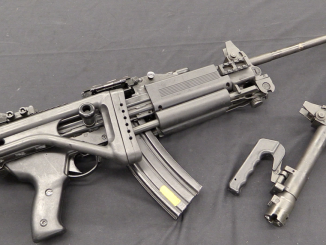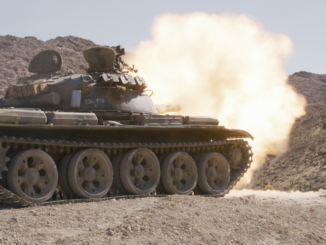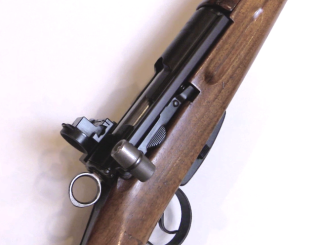“The UZI Submachine Gun: Examined” is a newly published book this year by David Gaboury – long time owner and operator of the uzitalk.com forum. Until now there has not really been any substantive written reference material on the Uzi, but Gaboury has certainly changed that!
The Uzi has not really seen many major variations in its design beyond the Uzi/Mini Uzi/Micro Uzi scaling (and the semiauto and full auto variations of each), but it has lived two rather distinct lives. One is the Uzi as a global military arm, and the other is the Uzi as an American commercial product – and this book covers both is excellent detail.
On the military side, the book begins with a substantial chapter on the initial development of the Uzi and Israeli submachine gun trials. A remarkably wide variety of guns were considered by the Israeli armed forces, and the trial ultimately came down to two domestic designs. The influence of the Czech ZK-476 and SA vz 23/4/5/6 designs are well explained, and much of the mythology about where the design came from is dispelled. Gaboury makes good use of both original documentary sources and firsthand conversation with those who were involved at the time the tell this story.
With the gun accepted, in production, and becoming very popular with Israeli troops, international sales become a possibility. Gaboury covers the adoption of the gun by the Dutch armed forces, followed by the German and South African militaries – as well as the licensed production by FN. He also examines other copies and adaptations, including Croatian, Japanese, and Chinese.
The second half of the Uzi story is that of its sale in the United States (including the use by US security organizations including the Secret Service). This is a story every bit as complex and detailed as the international military use of the gun, as US legal changes in 1968, 1986, 1989, 1994, and 2004 all play a major role in dictating changes that must be made to the guns for import and sale. In particular, Gaboury has detailed chapters on the major sellers of Uzis in the US – Action Arms, Group Industries, and Vector Arms (as well as many other smaller players).
While there may not be many major variations of the Uzi, there are a multitude of smaller changes to individual parts in both design and production technique, and Gaboury covers these in remarkable detail. If there is a flaw to the book, it is not in lack of detail, but perhaps in a bit of dryness to the writing. The information is clearly presented, but not particularly engaging to the reader who is only mildly interested in the subject. This is a minor criticism, however, and the book is an outstanding reference for anyone who has, well, really any questions at all about the Uzi.
Get a copy from the publisher or from Amazon:




“Uzi”
According to query in Russian wikipedia: https://ru.wikipedia.org/wiki/Uzi
Uziel Gal himself was against applying part of his name to this sub-machine gun, is that true or not?
Fact is that Uziel Gal, born as Gotthard Glas in Weimar, Germany in 1923, did not receive a single cent as royalty for his extremely succesful design. A friend of mine knew him personally and that clearly was what disappointed Uziel Gal most. He left Israel in his later years for the U.S.
Which is pretty standard when you’re an employee. Gal was an employee of IMI as an engineer and designer and invented the Uzi while on their payroll.
“The Uzi has not really seen many major variations in its design beyond the Uzi/Mini Uzi/Micro Uzi scaling (and the semiauto and full auto variations of each), but it has lived two rather distinct lives.”
Though Uziel Gal designed later Ruger MP9 sub-machine gun: http://modernfirearms.net/smg/usa/ruger-mp9-e.html
which, if I am not confused, fail to reach popularity of his earlier design
The SMG which became Ruger MP9 is conceptually and even visually very different from original design. When designing his original ‘samopal’ his main objective was substantial increase of user’s safety which he achieved extremely well. His later design was not in the same category – it was intended to improve first hit probability. This is why he chose to employ mechanism with closed breech and conventional hammer fire control.
I cannot speculate why he did not succeed with the latter; apparently name by itself is not guarantee of success. Also, there were at the time different directions including 5.56 carbines which took some wind out of SMG sails.
“(…)why he did not succeed with the latter(…)”
Simplest answer would be: timing. Uzi was introduced to production in 1954 when there was feel that World War III is possible, where several vehicle (both armored and not-armored) would be used, for crews of said vehicles, Uzi was good choice, as it is relatively short and provides better firepower than automatic pistol.
Ruger MP9 on the other hand was introduced in 1990s, in that time feeling of possibility of outbreak grand-scale war was smaller.
Also, by that time H&K dominated the accurate police & special forces SMG market with the MP5 so completely that there was little room for new competitors.
“SA vz 23/4/5/6”
I must note that it should be Sa. 23 / Sa. 24 / Sa. 25 / Sa. 26 or if you wish more short form: Sa. 23/24/25/26
Using vz. mean that beyond is year of introduction (2 last digits), thus it would be like sub-machine gun pattern 1923/4/5/6.
“(…)remarkably wide variety of guns were considered by the Israeli armed forces, and the trial ultimately came down to two domestic designs.(…)”
Weapon-wise Israeli forces situation at that time was similar to that of French – wide variety of weapons from various countries, but France ended with more “classic” sub-machine – MAT-49 – with magazine in front of trigger guard.
“The influence of the Czech ZK-476 and SA vz 23/4/5/6 designs are well explained, and much of the mythology about where the design came from is dispelled”
I want to note that if “wrapping around” moving parts around barrel was something considering nothing novelty, it was not in automatic pistols design and in effect also in machine pistols, like for example:
http://www.star-firearms.com/firearms/guns/smgD/index.shtml
is: “(…)was something considering nothing novelty(…)”
should be: “(…)was something considered novelty in sub-machine gun field(…)”
Czech support for Haganah and Palmach, kibbutz-based militia forces:
https://en.wikipedia.org/wiki/Arms_shipments_from_Czechoslovakia_to_Israel_1947%E2%80%9349
Source of those Me109 Bfs.
http://www.sztetl.org.pl/en/term/1080,haganah/
Polish provided military training for Betar–ancestor of the Likud bloc of parties–including Igun/ Etzl. Bibi Netanyahu was the first Israeli leader who didn’t grow up speaking Polish in the home…
Joe Sacco’s _Footnotes in Gaza_ infocomic includes interviews with Palestinian Fedayee supplied by Nasserite Egypt in cross border raids that resulted in Khan Younis and Rafah during the Sinai invasion of 1956. Some describe being armed with “Carl Gustaf” rifles, which I must assume are actually the 7.92x57mm Ljungman deriviative called the Hakim. IDF forces appear to have had lots of ex-British small arms including Brens, Lee Enfields, and Sten Guns, as well as Uzis and Czech Kar98ks.
Most nations desirous of an arms industry start out with the relatively simple SMG…
” Some describe being armed with “Carl Gustaf” rifles, which I must assume are actually the 7.92x57mm Ljungman deriviative called the Hakim.”
Or maybe “Swedish Mauser”? According to: https://en.wikipedia.org/wiki/Swedish_Mauser
it was also made by Carl Gustafs stads Gevärsfaktori. If manufacturer name was placed on that rifle, it might be called so by users.
As far as I am aware, Swedish technicians assisted Egypt in the manufacture of the “Hakim” 7.92x57mm self-loading rifle, since it is basically a larger caliber copy of the AG42 Ljungmann 6.5x55mm rifle. The Carl-Gustaf kpist m/45 was copied and a simplified variant of the “Port Said” as it was known came out with no barrel jacket and an M3-style bent wire stock instead of the original side-folder. There are even images of Ernesto “Che” Guevara handling one on his visit to Egypt.
I have never heard of Swedish Mausers in use by Egypt. The nation’s army used lots of British small arms, albeit supplemented here and there in WWII by captured Italian weapons. Under King Farouk SAFN or FN49s made by FN Herstal in 8x57mm Mauser were acquired since the British .303″ was rimmed. It was that rifle that was to be supplemented and replaced by the Hakim before things went Soviet, equipment and doctrinally, after 1956. The reference of the Fedayeen informants mentions a rifle and not an SMG.
https://www.cia.gov/library/readingroom/docs/CIA-RDP82-00457R009200360002-3.pdf
Forgot to add the above from ’51
??
Ben-Gurion was the only Polish speaker. Sharett, Meir, Eshkol were Russian speakers.
Yitzhak Rabin was born in Jerusalem and spoke Hebrew.
Begin and Shamir spoke Polish but Begin was raised in Belarus, not Poland. The Polish army did provide some organizational training to Betar members (the majority of Betar membership were in Poland) but that was in the 1930s.
I suppose this is something you will appreciate:
https://www.valka.cz/14732-Ing-Jaroslav-Holecek-a-jeho-samopaly-vz-23-25-a-24-26?utm_source=valka_cz&utm_medium=article&utm_campaign=similar
“J.Holecek and his submachine guns”… you understand Czech well enough afaik. There is continuation – see top of list on left. There is bunch of pictures and even drawings, for those who do not care for peculiar foreign language, but still want to see.
As far as crediting Holecek’s design as direct predecessor to Uziel Gal’s SMG I am not that sure. There were in addition to “samopal” also some German designs of similar layout before end of war (only on level of prototypes).
I was first able to examine sa.23 when I was school kid (I used to go to summer camp which was almost directly on border with DDR; border was guarded). That time I was sufficiently impressed to drool over them. By the time when I saw Uzis’ creation up close I realized the improvements he made. On balance, I’d say UZI is better gun (namely sturdiness of receiver and phenomenal folding stock). The incremental improvement at its best.
“I suppose this is something you will appreciate:”
Wait, does this:
Samopal musel vydržet (…) přejetí traktorem.
mean that sub-machine gun was supposed to be work after tractor ride over it?
Anyway it looks that vz. 23 and vz. 24 and vz. 25 and vz. 26 were officially used.
BTW: Entry for CZ 247 in Modern Firearms:
http://modernfirearms.net/smg/chex/submachine-gun-cz-247-e.html
says that sold in noticeable quantities to certain African and South American countries
Do you know which? Also it says that One peculiar feature of the CZ 247 is that magazine housing is able to rotate and put magazine either below the gun or to the left of the gun, and CZ 247 submachine gun could be fired when magazine is in either position.
Is that possible without tool?
🙂
Your translation is correct, although I doubt that was the original design intent. Tractor would likely made mash out of it. What is almost mind-boggling is the amount of prototypes made between 1946-48 by both competing teams. I am sure there were number of books written on the subject in which Mr. Fencl has prominent author’s spot. I had some while living in old country – nothing of which I could take with me.
That CZ247 is similar in appearance to vz.38 Kulomentna pistole. If you want to know where Czech SMGs were exported, I am not the person to ask. But in my limited knowledge they ended up in variety of African countries, including Rhodesia and South Africa. This sounds almost as absurdity considering the fact that official Csl. policy was profoundly anti-apartheid.
“That CZ247 is similar in appearance to vz.38 Kulomentna pistole.”
According to Modern Firearms CZ 247 is variant of the pre-war Vz.38 submachine gun, chambered for 9×19 Luger ammunition, with minor alterations.
Another difference beyond that rotating magazine housing, seems to be that Vz. 38 is full-auto weapons, when CZ 247 is selective-fire (short pull of trigger = semi, long = full).
Modern firearms also notes that CZ 247 has built-in special device for loading magazine from 8-round clip, though it is unclear for me why such packing (8-round clip) was developed and if it was specially for CZ 247 or taken from other (earlier) project.
Bolivia
The secessionist Biafra in the Nigerian Civil War
Also, here is an interesting article discussing possibility that ZK476 might have been starting point for Mr. Gal:
http://www.rucevzhuru.cz/index.php/technika/210-podobnost-sa-24-a-sa-26-a-uzi.html
The mentioned ZK476 was work of Koucky brothers from team Zbrojovka Brno and in fact there are some visible cues between it and future Israeli weapon. Mrs. Holecek and Cermak (creator of vz.58) were part of team Zbrojovka Strakonice. They were in competition for future Csl. service weapon(s). Therefor, the trend toward compact, magazine in grip SMG was collectively shared by quite a few people.
“Therefor, the trend toward compact, magazine in grip SMG was collectively shared by quite a few people.”
British MCEM-2 is here worth of note:
http://modernfirearms.net/smg/brit/mcem-2-e.html
Magazine-in-grip sub-machine gun design was, beyond Czechoslovakia, also used in Polish (at that time Poland was another part of Warsaw Pact) PM-63 codenamed RAK.
This path of development was different of that chosen in Soviet Union – sub-machine gun as class of weapon were considering needless for general usage, after introduction of AKS (AK with folding stock) and APS (Stechkin machine pistol), in early 1970s competition for new sub-machine gun started, some proposition were filled but none satisfy (very ambitious) requirements so not production, anyway 2 of these designs were later “resurrected” and are now known as Kiparis and KEDR (both for 9×18).
“Therefor, the trend toward compact, magazine in grip SMG was collectively shared by quite a few people.”
It looks that need for small sub-machine gun (or machine pistol depending on taxonomy) was also identified by one Australian during Second World War, namely Russell Robinson; his creation is now know as Robinson Model 11:
http://www.smallarmsreview.com/display.article.cfm?idarticles=1985
as you can see from photo, dubbed ROBBIEGUN. It has peculiar solution which mean lower felt recoil and better accuracy in full-auto fire.
Notice that on title photo, slide of this weapons is in full backward position and grooves on external surface of barrel.
(Robinson also crafted .50″ machine gun for aircraft application, which was smaller and has softer recoil than then used .50″ Browning machine gun, but that is another story)
“predecessor”
Now I found, query in littlegun for DICTATOR automatic pistol:
http://www.littlegun.be/arme%20belge/artisans%20identifies%20e%20f/a%20fab%20armes%20reunies%20gb.htm
which states that:
(…)construction of the pistol is very interesting as it was with no doubt the first “telescope-action”, a construction which appeared in 1944-1945 at machine-guns an was celebrated at that time as big progress of gun-development(…)
It is worth nothing that apparently, in Europe before Great War, word DICTATOR must have positive (or at least neutral) connotation. Though names chosen for automatic pistols and revolvers were another than now – take for example Galand Tue-Tue – I think no modern producers would be willing to name his revolver Kill-Kill
So what about Ruger MP9??
There is no specific information like disassembly,schematics or any manuals…
I know there an instruction manuals exist on Ruger MP9,the one I seen was sold with gun itself in sealed envelope…..
It is hard to believe but by contacting Sturm Ruger they told me that there is no more instruction manuals available for Ruger MP9,which is very hard to believe,they must have something in their database…
Maybe somebody can scan pages 78 to 87 where everything describes about Ruger MP9 and it’s development???
More interesting to find an schematics of functionality and disassembly procedure,this is what missing most on Ruger MP9….
How ironic,Ruger MP9 was designed and developed by Uziel gal and underwent into manufacturing under Sturm Ruger company,however after 90’s all Ruger MP9’s stopped been manufactured…..
Despite complete submachine gun even parts kit super rare to find and ofcourse instruction manual itself…
From my personal study Ruger MP9 is equivalent to Polish PM84P/PM98 Glauberyt,some components looks identical some ways like hammer assembly,main sear and auto sear..
This would also appear in MP7A1,seems like all closed bolt operation firearms it have identical trigger mechanism…
UZI Pro is very identical to Japanese version of UZI which is also closed bolt function..
It is very sad that many firearms replicated from something else that already was exist,PM84 Glauberyt was first of it’s kind than Ruger MP9 and Russian Buk OC-22 or PP22 appeared which operates same way..
Russians improved cocking handle function but everything else looks very PM84 ish..
But unlike PM84P which later became upgraded into PM98 is still in production and service of Polish firearms,Ruger MP9 become unicorn of firearms world just like Italian Socimi/Franchi 821 as well which we can refer as more improved UZI version,the recoil assembly located at top center of bolt which creates perfect balance for bolt preventing wable left or right,the main upper receiver is fully milled unlike Mini UZI which have sheet metal stamped and consider weak in construction..
By furthermore Socimi 821 dismounts easier,by depressing recoil rod at end cap cap rotates and removes from receiver and allow access to bolt,further by depressing trigger and pulls cocking handle bolt removes from housing,by pressing retaining button at front barrel nut unscrews and barrel comes out,by removing 2 retaining pins at bottom trigger housing separates from receiver..
This would conclude basic disassembly of Socimi/Franchi 821,it aren’t much different from UZi at all and would be consider UZI MK2…